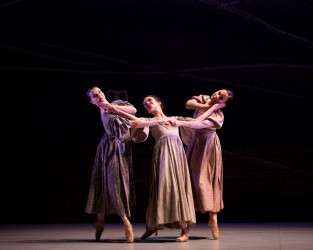 United Kingdom Northern Ballet’s Jane Eyre: Soloists, Coryphée and Dancers of Northern Ballet, Northern Ballet Sinfonia / John Pryce-Jones (conductor). Sadler’s Wells, London, 15.5.2018. (JO’D)
United Kingdom Northern Ballet’s Jane Eyre: Soloists, Coryphée and Dancers of Northern Ballet, Northern Ballet Sinfonia / John Pryce-Jones (conductor). Sadler’s Wells, London, 15.5.2018. (JO’D)

in Jane Eyre (c) Emma Kauldhar
Cast:
Jane Eyre – Dreda Blow
Edward Rochester – Javier Torres
Bertha Mason – Victoria Sibson
Reverend St.John Rivers – Sean Bates
Helen Burns – Kiara Flavin
Mrs Fairfax – Pippa Moore
Production:
Music Compiled and Composed by Philip Feeney
Choreography, Direction and Scenario – Cathy Marston
Set and Costume Design and Scenario – Patrick Kinmonth
Lighting Design – Alastair West
The applause for Jane Eyre (2017) at Sadler’s Wells expressed a deep satisfaction. In the closing moments of the ballet, choreographer Cathy Marston skilfully undercuts the expected reunion of Jane and the now blind Mr. Rochester. The focus is on Jane alone. For Charlotte Brontë’s eponymous heroine it would seem there is no happy ending, only a journey that continues.
This fitting finale links back to all that has been good in the previous two acts. Cathy Marston’s movement style combines dramatically free and flexible waist, upper back, shoulders and elbows with the precise footwork of classical ballet. Hands, the backs of them as well as the palms, are particularly expressive. Using their hands, and arms, Northern Ballet’s actor-dancers adopt poses full of meaning like those seen in photographs of ballets by Nijinska.
‘For Cathy,’ the programme notes tell us, ‘stories inform dance.’ Previous work by the choreographer include versions of Ibsen’s Ghosts, Chekhov’s Three Sisters and Shakespeare’s Hamlet. Watching Jane Eyre, though, the overall impression is that dance loses out to narrative. The telling of so much story means that despite the charged choreography, moments of drama are not sufficiently worked up: everything simmers rather than boils.
Cathy Marston has also made one or two surprising narrative decisions. A powerful, behind-a-scrim prologue that flashes forward to Jane and Rochester at the novel’s climax is almost immediately weakened by the entrance of a group of anachronistically dressed, male dancers. The choreographer has used small groups as a corps very effectively before, in Witch-hunt (2013) and The Suit (2018), for example. This corps is effective later on, when the men appear bearing candles in the gloom of Thornfield Hall. Inexplicably prancing and leaping around the distressed Jane of the prologue, however, they simply slow the action down.
More surprisingly, and disappointingly, Bertha Mason (Rochester’s wife) is a figure without context. Her brother, Richard; their West Indian background: all of that is excluded. She is simply a red-haired woman, in a torn red dress, who overtly expresses the sexual desire for Rochester that Jane Eyre only shows through the fluttering of one hand. It is hard to understand why Cathy Marston did not let Bertha Mason’s story inform this dance.
If the choreographer’s interest in narrative might explain the unexceptional nature of the ‘composed and compiled’ score, the design of sets and costumes (albeit Regency rather than mid-Victorian) is striking. Before he appears, Rochester’s presence at Thornfield is represented by an exaggeratedly high-backed wing-chair. This is reduced to a skeleton of itself after the fire.
About the performances there can be no doubt: all strong; all finely judged. Kiara Flavin, as Jane’s school-friend, Helen Burns, stands out from the moment she slowly raises her head in front of the tyrannical Reverend Brocklehurst. After an entrance blurred by the grey-clad corps around him, Javier Torres is a forceful and substantial Rochester. Dreda Blow, as Jane Eyre, carries the whole ballet: looking back in pity at her younger self; experiencing happiness and despair; implying at the end that while this has been her story, it is also, in some way, one that everybody shares.
JohnO’Dwyer
